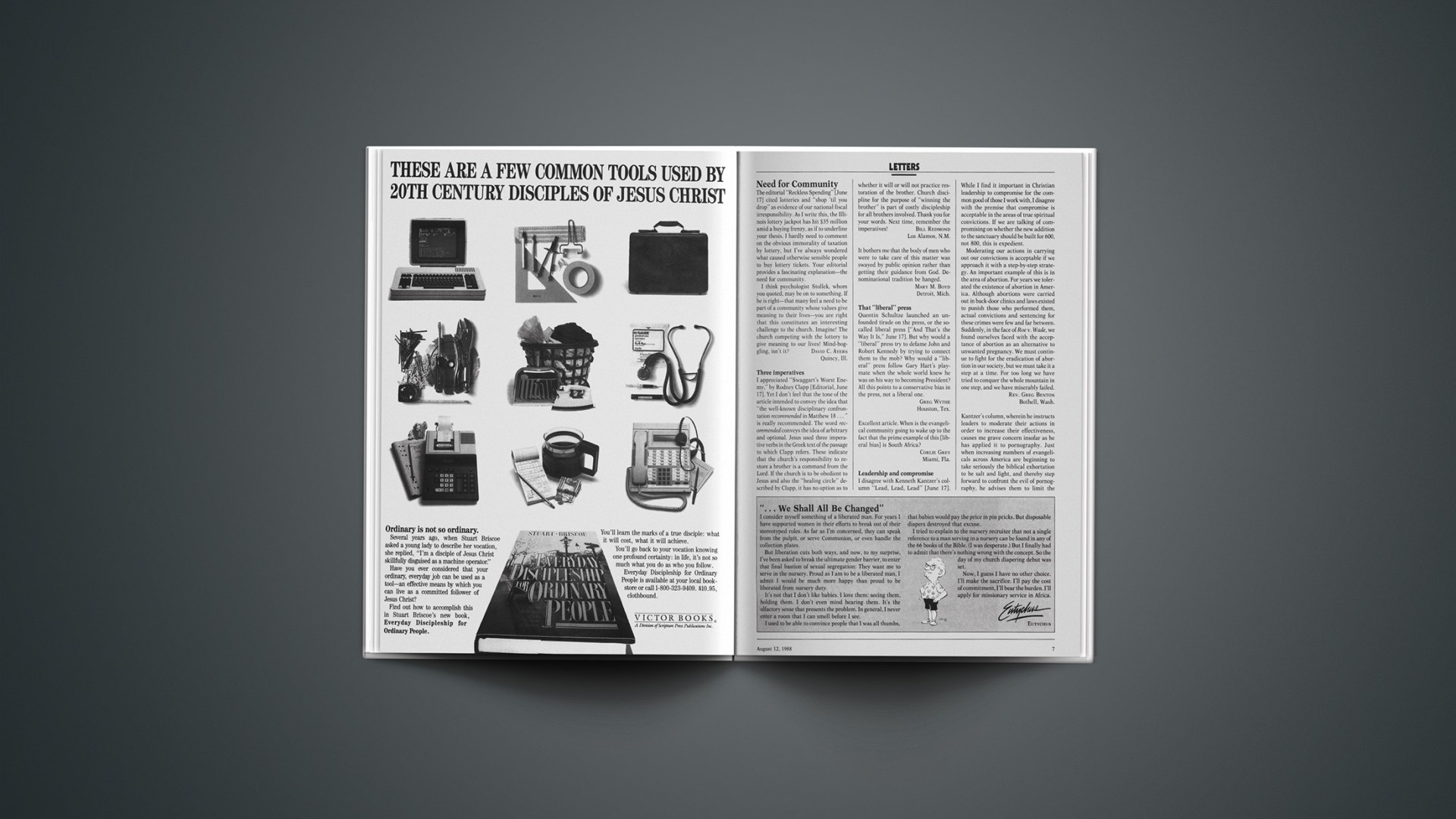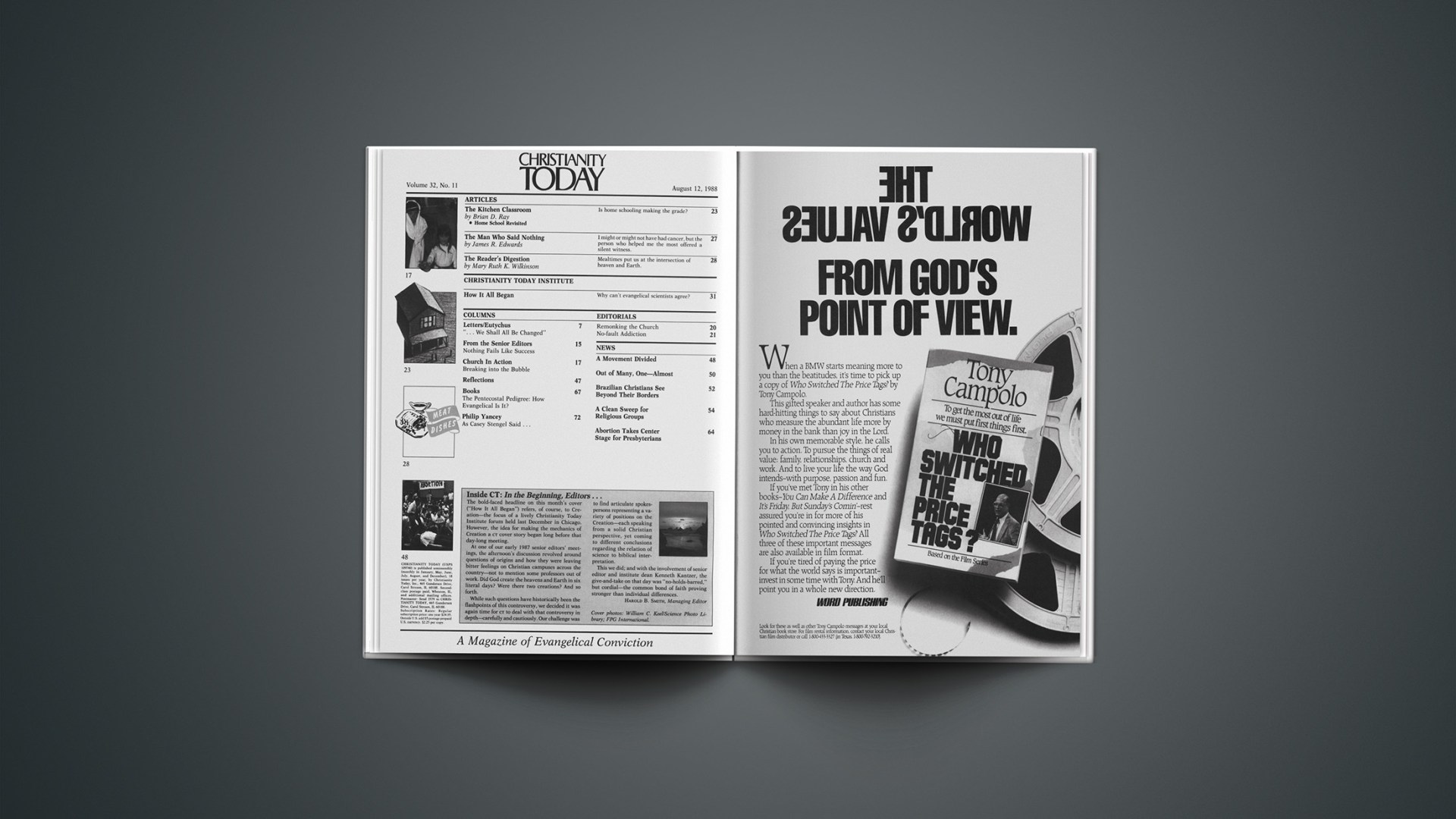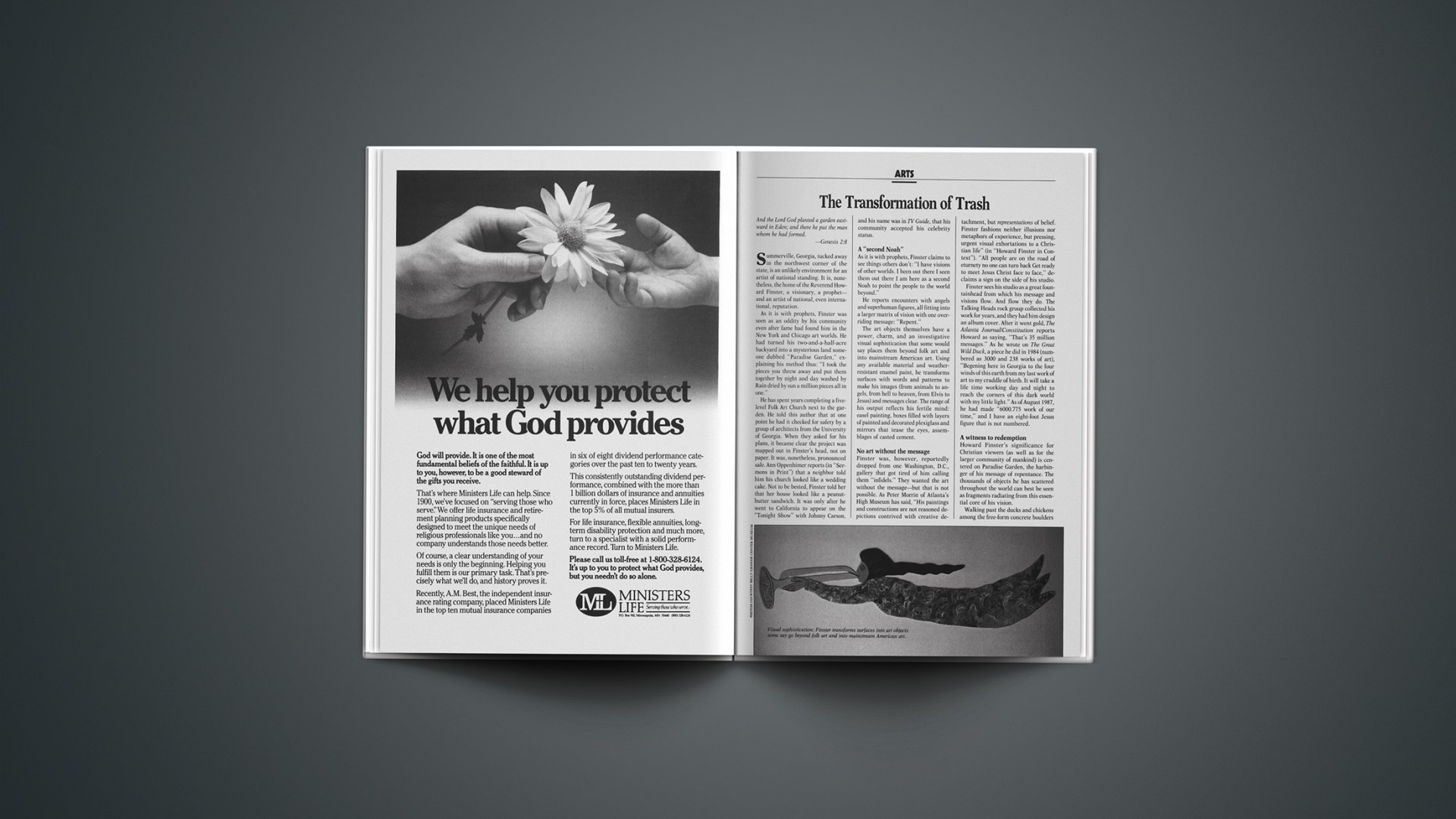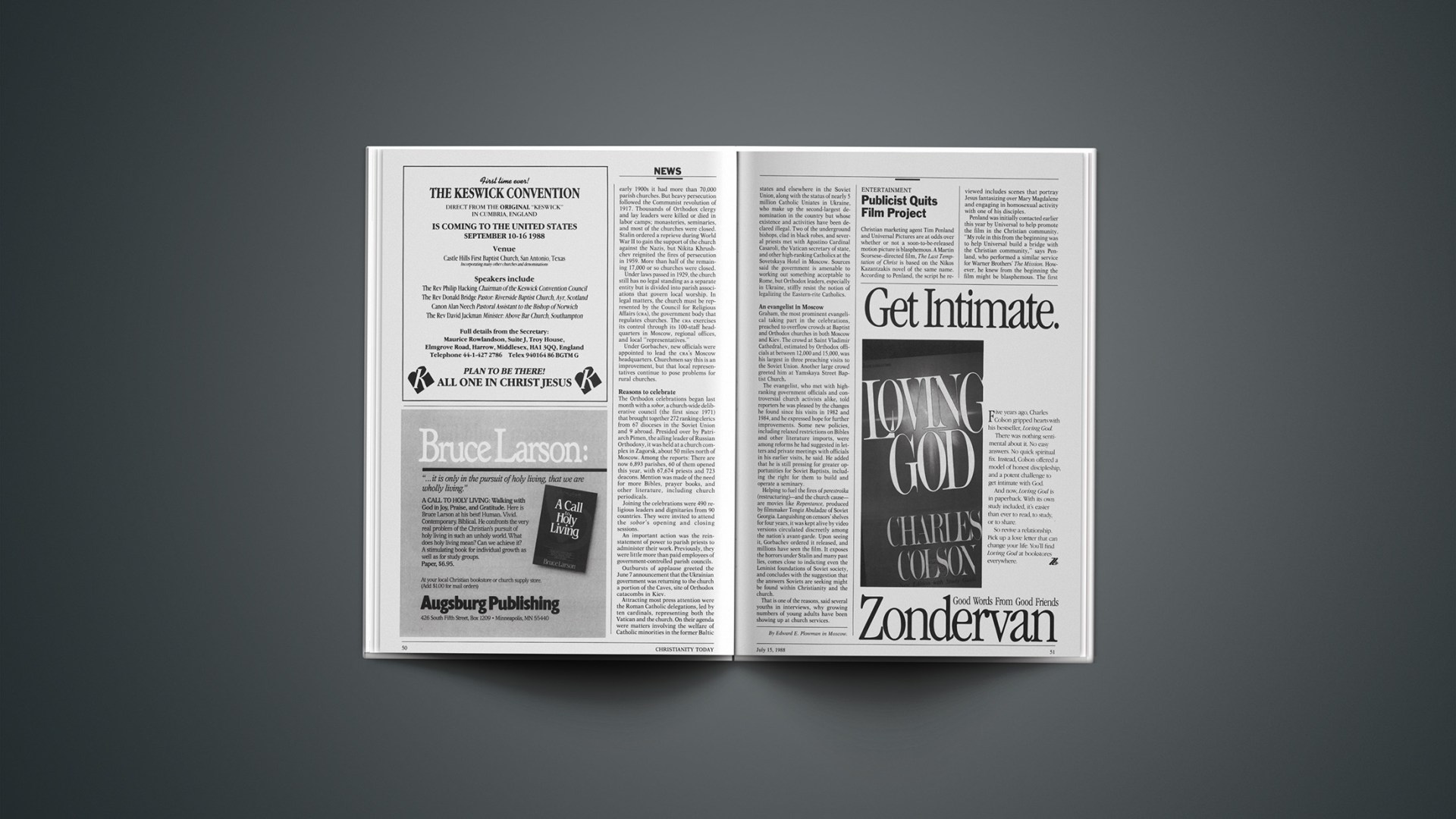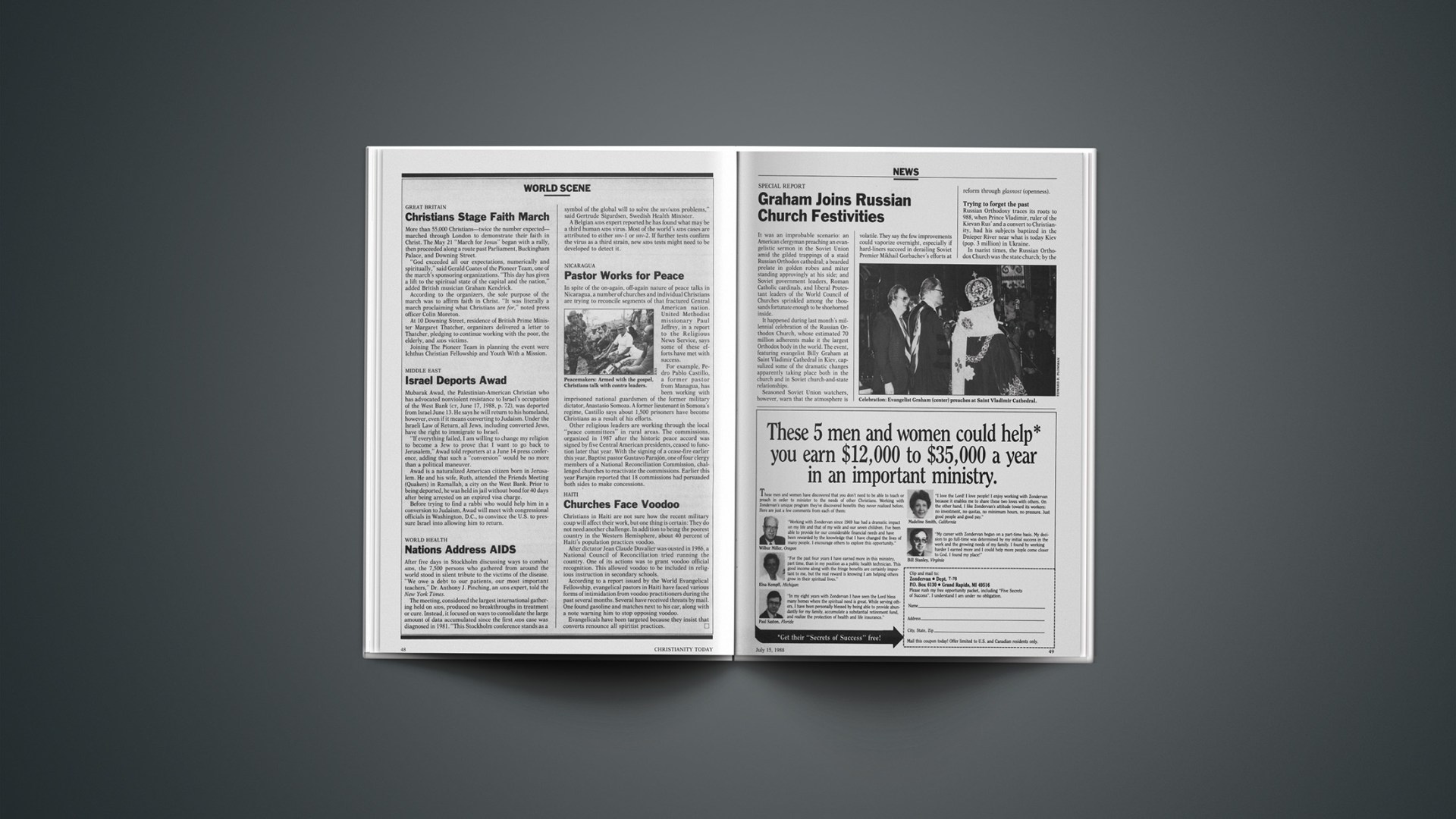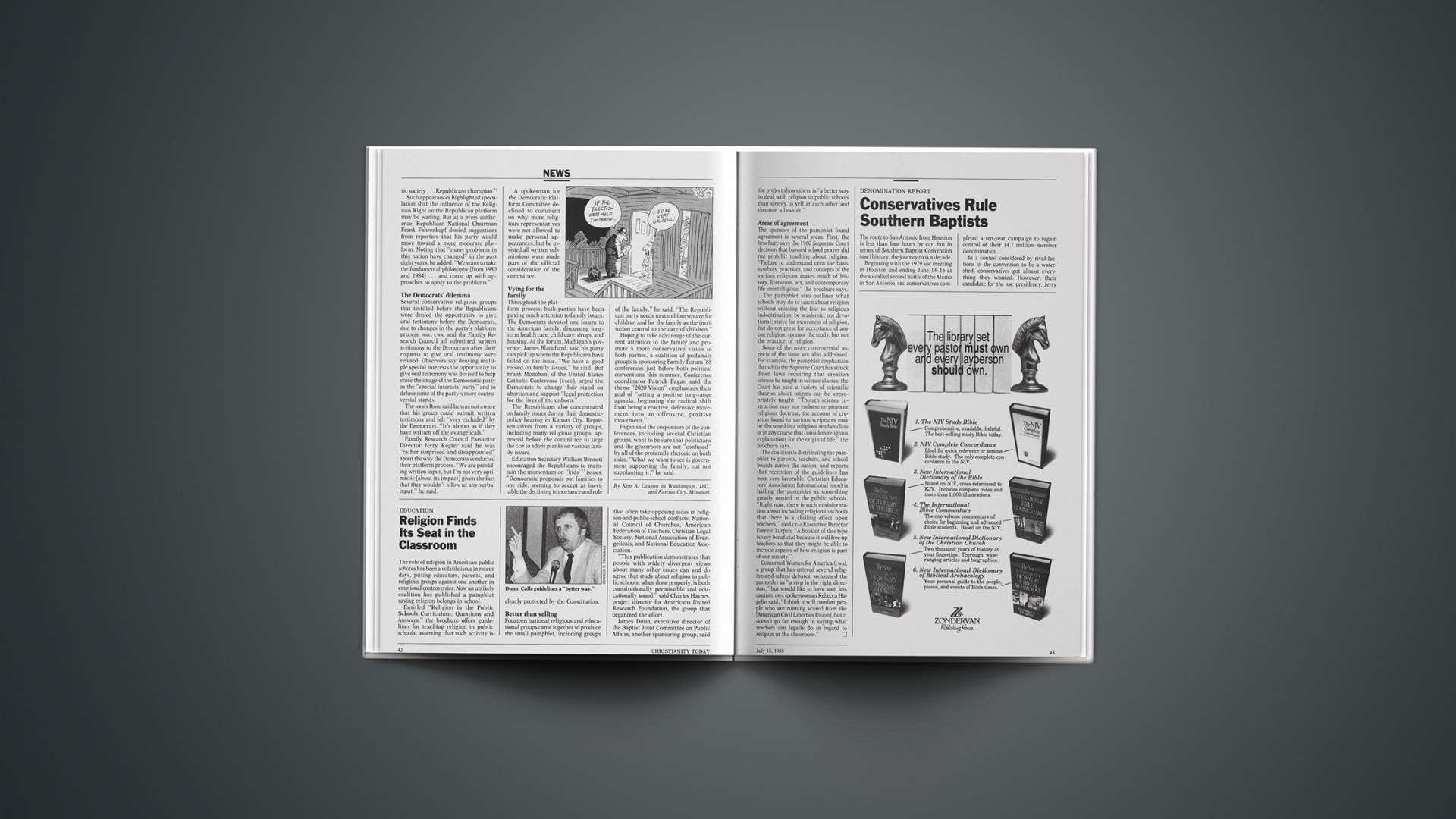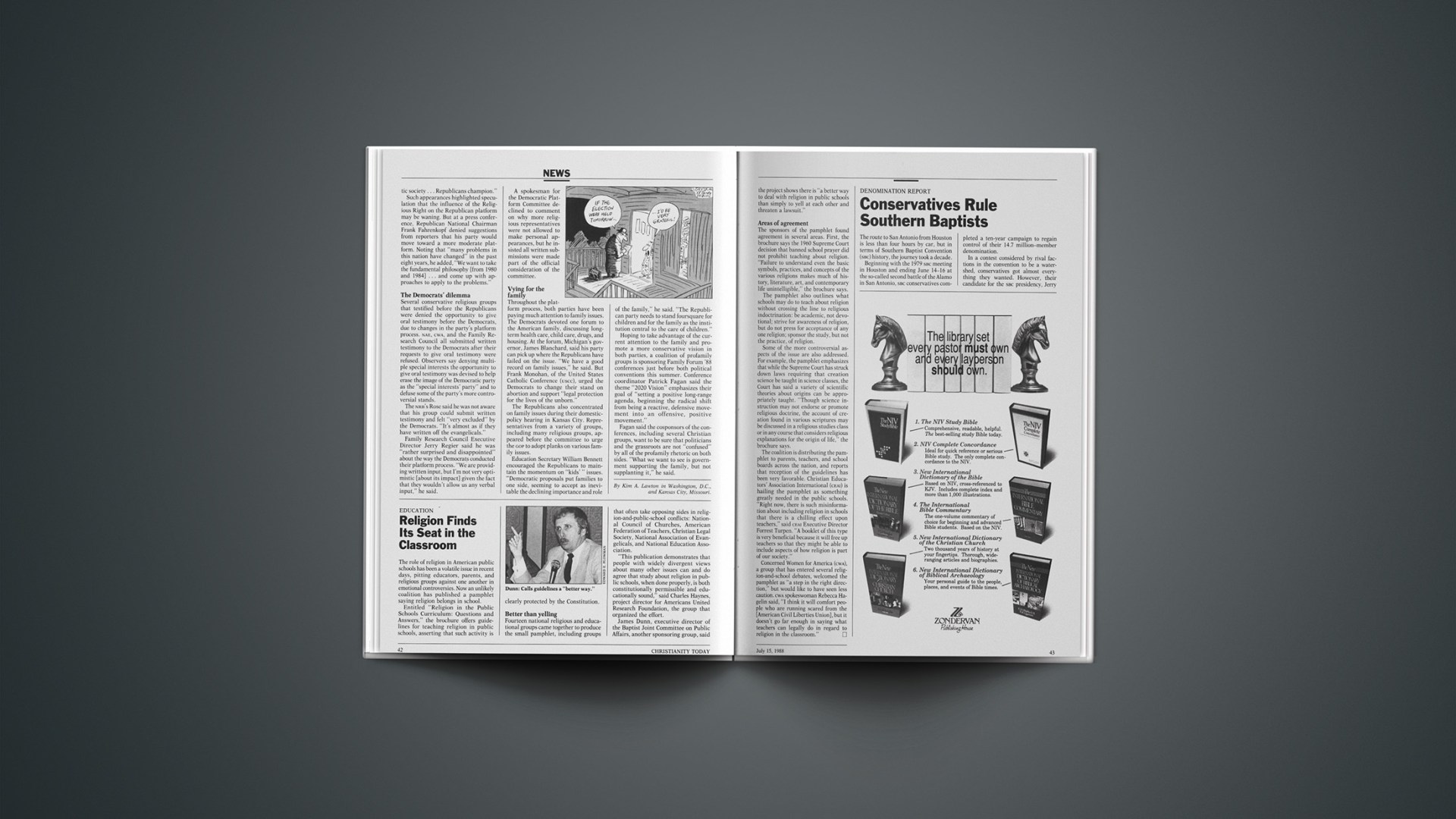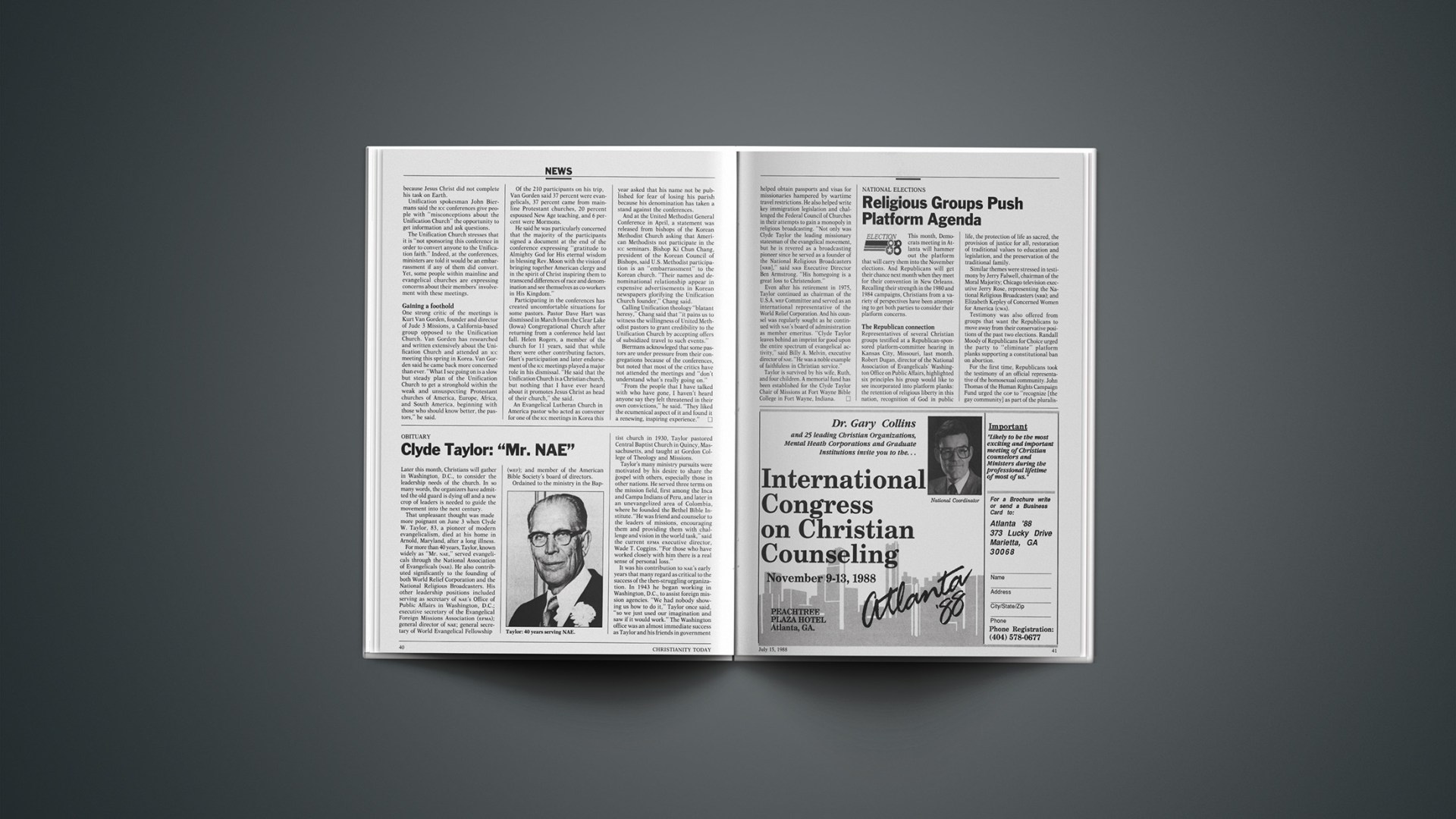Need for Community
The editorial “Reckless Spending” [June 17] cited lotteries and “shop ‘til you drop” as evidence of our national fiscal irresponsibility. As I write this, the Illinois lottery jackpot has hit $35 million amid a buying frenzy, as if to underline your thesis. I hardly need to comment on the obvious immorality of taxation by lottery, but I’ve always wondered what caused otherwise sensible people to buy lottery tickets. Your editorial provides a fascinating explanation—the need for community.
I think psychologist Stollek, whom you quoted, may be on to something. If he is right—that many feel a need to be part of a community whose values give meaning to their lives—you are right that this constitutes an interesting challenge to the church. Imagine! The church competing with the lottery to give meaning to our lives! Mind-boggling, isn’t it? DAVID C. AYERS
Quincy, Ill.
Three imperatives
I appreciated “Swaggart’s Worst Enemy,” by Rodney Clapp [Editorial, June 17]. Yet I don’t feel that the tone of the article intended to convey the idea that “the well-known disciplinary confrontation recommended in Matthew 18 …” is really recommended. The word recommended conveys the idea of arbitrary and optional. Jesus used three imperative verbs in the Greek text of the passage to which Clapp refers. These indicate that the church’s responsibility to restore a brother is a command from the Lord. If the church is to be obedient to Jesus and also the “healing circle” described by Clapp, it has no option as to whether it will or will not practice restoration of the brother. Church discipline for the purpose of “winning the brother” is part of costly discipleship for all brothers involved. Thank you for your words. Next time, remember the imperatives! BILL REDMOND
Los Alamos, N.M.
It bothers me that the body of men who were to take care of this matter was swayed by public opinion rather than getting their guidance from God. Denominational tradition be hanged.
MARY M. BOYD
Detroit, Mich.
“… We Shall All Be Changed”
I consider myself something of a liberated man. For years I have supported women in their efforts to break out of their stereotyped roles. As far as I’m concerned, they can speak from the pulpit, or serve Communion, or even handle the collection plates.
But liberation cuts both ways, and now, to my surprise, I’ve been asked to break the ultimate gender barrier, to enter that final bastion of sexual segregation: They want me to serve in the nursery. Proud as I am to be a liberated man, I admit I would be much more happy than proud to be liberated from nursery duty.
It’s not that I don’t like babies. I love them: seeing them, holding them. I don’t even mind hearing them. It’s the olfactory sense that presents the problem. In general, I never enter a room that I can smell before I see.
I used to be able to convince people that I was all thumbs, that babies would pay the price in pin pricks. But disposable diapers destroyed that excuse.
I tried to explain to the nursery recruiter that not a single reference to a man serving in a nursery can be found in any of the 66 books of the Bible. (I was desperate.) But I finally had to admit that there’s nothing wrong with the concept. So the day of my church diapering debut was set.
Now, I guess I have no other choice. I’ll make the sacrifice. I’ll pay the cost of commitment, I’ll bear the burden. I’ll apply for missionary service in Africa.
EUTYCHUS
That “liberal” press
Quentin Schultze launched an unfounded tirade on the press, or the so-called liberal press [“And That’s the Way It Is,” June 17]. But why would a “liberal” press try to defame John and Robert Kennedy by trying to connect them to the mob? Why would a “liberal” press follow Gary Hart’s playmate when the whole world knew he was on his way to becoming President? All this points to a conservative bias in the press, not a liberal one.
GREG WYTHE
Houston, Tex.
Excellent article. When is the evangelical community going to wake up to the fact that the prime example of this [liberal bias] is South Africa?
CORLIE GREY
Miami, Fla.
Leadership and compromise
I disagree with Kenneth Kantzer’s column “Lead, Lead, Lead” [June 17].
While I find it important in Christian leadership to compromise for the common good of those I work with, I disagree with the premise that compromise is acceptable in the areas of true spiritual convictions. If we are talking of compromising on whether the new addition to the sanctuary should be built for 600, not 800, this is expedient.
Moderating our actions in carrying out our convictions is acceptable if we approach it with a step-by-step strategy. An important example of this is in the area of abortion. For years we tolerated the existence of abortion in America. Although abortions were carried out in back-door clinics and laws existed to punish those who performed them, actual convictions and sentencing for these crimes were few and far between. Suddenly, in the face of Roe v. Wade, we found ourselves faced with the acceptance of abortion as an alternative to unwanted pregnancy. We must continue to fight for the eradication of abortion in our society, but we must take it a step at a time. For too long we have tried to conquer the whole mountain in one step, and we have miserably failed.
REV. GREG BENTON
Bothell, Wash.
Kantzer’s column, wherein he instructs leaders to moderate their actions in order to increase their effectiveness, causes me grave concern insofar as he has applied it to pornography. Just when increasing numbers of evangelicals across America are beginning to take seriously the biblical exhortation to be salt and light, and thereby step forward to confront the evil of pornography, he advises them to limit the focus of their active opposition to that with which their fellow Americans “would gladly unite.” While I agree that might result in broader-based coalitions and more effective social and political action concerning other public issues, evangelicals should not, and for that matter, need not, moderate efforts to combat pornography by drawing the line at child pornography.
The war against pornography will be won largely by overcoming ignorance and apathy among evangelical leaders. Once properly educated and equipped, they can then “Lead! Lead! Lead!” their flocks toward overcoming not only child pornography, but also obscenity.
C. BRADLEY KEIRNES
Phoenix, Ariz.
Yancey: Right on target
Philip Yancey’s column of June 17, “The Problem of Pleasure,” struck a familiar note. Although at the age of 16 I had yet to read Chesterton, the thought hit me that there were too many wonderful things in life for it to be the product of a random evolutionary process; God had to be real. This was my spiritual turning point. A few weeks later at an evangelistic film, I committed my life to Christ. Now, 15 years later, I am on the staff of Campus Crusade for Christ and a graduate student in philosophy. As I have the opportunity to speak on the problem of evil on various campuses, I always bring up the problem of pleasure.
Yancey’s essay was right on target.
GREG GANSSLE
Campus Crusade for Christ
Pawtucket, R.I.
Yancey says he has never seen a book on the problem of pleasure. Perhaps he can add this book to his reading list: John H. Gerstner, The Problem of Pleasure: A Primer (Presbyterian and Reformed Pub. Co., 1983). Although only 27 pages, Gerstner always has something worthwhile to say. DAVID WEGENER
Madison, Wis.
Restoration a poor example?
As I read your news report [about Gordon MacDonald], “Good News for a Fallen Leader” [June 17], at first I was glad. Then I was sad to realize that we are confusing the difference between restoration to fellowship in the body of Christ with restoration to leadership.
Paul said in 1 Corinthians 9:27, “But I keep under my body, and bring it into subjection: lest that by any means, when I have preached to others, I myself should be a castaway.” Paul is speaking of service, not salvation. All of this error concerning restoration seems to be a result of leaders wrongly dividing the Word of Truth. All of this restoration to leadership after adultery is a very poor example to Christian youth. Where in the New Testament was any leader who fell ever restored to leadership? Today’s church is corrupt and without power just like the days before the Reformation. We restore the big shots and forget those who were hurt by them. Many who are involved in the work of the Lord seem to lose sight of the Lord of the work. I am deeply concerned.
JACK WYRTZEN
Word of Life Fellowship, Inc.
Schroon Lake, N.Y.
I was overjoyed to read “Good News for a Fallen Leader.” I commend Gordon MacDonald and his wife for their faithfulness to God’s Word and to those who stood with them during a very difficult time. After we’ve seen and heard so much of those who were, at least till now, unwilling to submit themselves to brothers in the Lord for restoration, your news article was a breath of fresh air. I’m only sorry it didn’t get a front-page spread. MacDonald’s restoration to the gospel ministry after submitting himself to church discipline for restoration shows the power of the grace of God in the sinner and in the church.
REV. DENNIS MADEIRA
New Life Community Church
Dallas, Pa.
Drugs not an issue?
My evening news tells me the number-one concern of Americans is the drug problem. I read your “CT Poll: What Do Christians Want from the Candidates?” [News, June 17]. I searched, but found not one word about drugs. Can’t we expect your magazine to deal with the most pressing issues?
ALICE M. BENSON
High Teens
Albuquerque, N.M.
Care for the body
With reference to Phillip Yancey’s article “Death Whispers” [May 13], I know some for whom a health club is not a “pagan temple.” Rather, it is a needed and disciplined way, first of all, to care for themselves. Indeed, their focus is on their body, but not for physical reasons. Their membership is to preserve only one part of themselves. Their sharpened and tuned body is necessary to be a better steward of their life and calling: their thinking can be clearer, their actions more zestful, and their prayers more intense. So, however you do it, care for your body is an important part of serving your Lord. It is one way to show your thankfulness for his gift of life.
DUANE E. VANDERBRUG
Your article “Death Whispers” meant a lot to me. At the ripe old age of 36, I’ve already lost two friends to cancer. Last week on my job as a home health aide, I was asked for the first time to sit with a man about to die. There was nothing I could do but sit, think, and occasionally pat his shoulder as he gasped for air. As I sat there, I remembered sitting with my sister through her labor. How similar the two seemed: heavy breathing; waiting, with little to do but comfort. On the other side of labor was great joy as a beautiful baby was brought forth. On the other side of death—for the believer—great joy as we slip into Jesus’ open arms!
MARY KLING
Sicklerville, N.J.
China’s church leadership
I read the news report of Billy Graham in China with interest [June 17]; Ed Plowman seems to suggest there are two major concerns facing the Chinese church: (1) lack of seminary-trained clergy, and (2) the graying of leadership.
The two are related, of course, because they both focus on leadership, a topic of extreme importance to the church. However, scripturally speaking, we ought to rejoice at the “graying of the church.” Church leaders were called elders for a very good reason—they were elders—gray beards.
The leadership crisis is not in China but in Western countries that try to make elders out of youngers, and who replace equipping people in the context of the caring Christian community with a graduate education that majors on minors. GARY R. SWEETEN
College Hill Presbyterian Church
Cincinnati, Ohio

